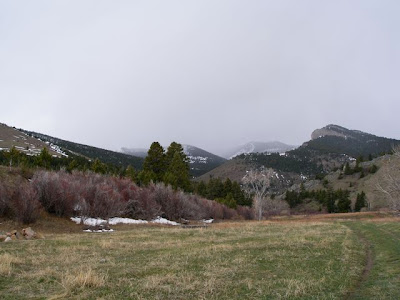The sun is shining. It is springtime in Montana, through the window I can hear a Western Meadowlark singing. My wife spotted a fresh baby antelope this morning behind the house. And, I am stuck in the office working on my computer.
In one way this post has nothing to do with elk hunting, although, if you are reading this you are probably seeing it on a computer. In that way it has everything to do with Montana Elk Hunting.
A couple of days ago, I noticed my modem status meter running when my mail program was closed and I wasn't actively on the internet. I have a mac and the internet connect shows a bar graph showing send and receive information. I did a small test--probably not a scientific test and found that if I typed a word on a Word document, there was activity on the meter. My virus blocking software must not have picked it up.
I went to my other computer and surfed for other spyware removal tools, returned to the infected computer and downloaded the software. It found over 80 files that were not part of the system. The files were at the root of my system and could not be accessed by me. I couldn't even look at them. The spyware could not remove the files and I couldn't get them to delete.
It must be noted that as soon as the download of the anti-spyware was completed I got off the internet.
My only real option was to call some computer geek company and have them try to remove it or erase my hard drive and start over.
I took the second option. I don't think I lost much, but I will spend a remarkable spring weekend getting things reloaded.
I'm not sure where I picked up the spyware, or how long it had been on the drive. It is upsetting to me that there are so many obviously capable people that don't use their talents for good, but to cheat and steal from others.
There is a lot of good information about spyware, malware and viruses.
Wikipedia gets a lot of bad press, but if you want a quick overview, with links to sources it is a good start. For information at Wiki, go to Spyware on Wikipedia.
For better info go to the Federal Trade Commission, Internet Privacy & Security page, the FTCs On Guard Online source of topics, games and videos on internet security, or FTCs On Guard Online Malware Page.
I have included the following tips from the malware page:
If you suspect malware is on your computer:
- Stop shopping, banking, and other online activities that involve user names, passwords, or other sensitive information.
- Confirm that your security software is active and current. (emphasis mine) At a minimum, your computer should have anti-virus and anti-spyware, and a firewall.
- Once your security software is up-to-date, run it to scan your computer for viruses and spyware, deleting anything the program identifies as a problem.
- If you suspect your computer is still infected, you may want to run a second anti-virus or anti-spyware program--or call in professional help.
- Once your computer is back up and running, think about how malware could have been downloaded to your machine, and what you could do to avoid it in the future.
- Don't click on a link in an email or open an attachment unless you know who sent it and what it is. Links in email can send you to sites that automatically download malware to your machine. Opening attachments--even those that appear to come from a friend or co-worker also can install malware on your computer.
- Download and install software only from websites you know and trust. Downloading free games, file sharing programs, and customized toolbars may sound appealing, but free software can come with malware.
- Talk about safe computing. Tell your kids that some online activity can put a computer at risk: clicking pop-ups, downloading "free" games or programs, or posting personal information.































